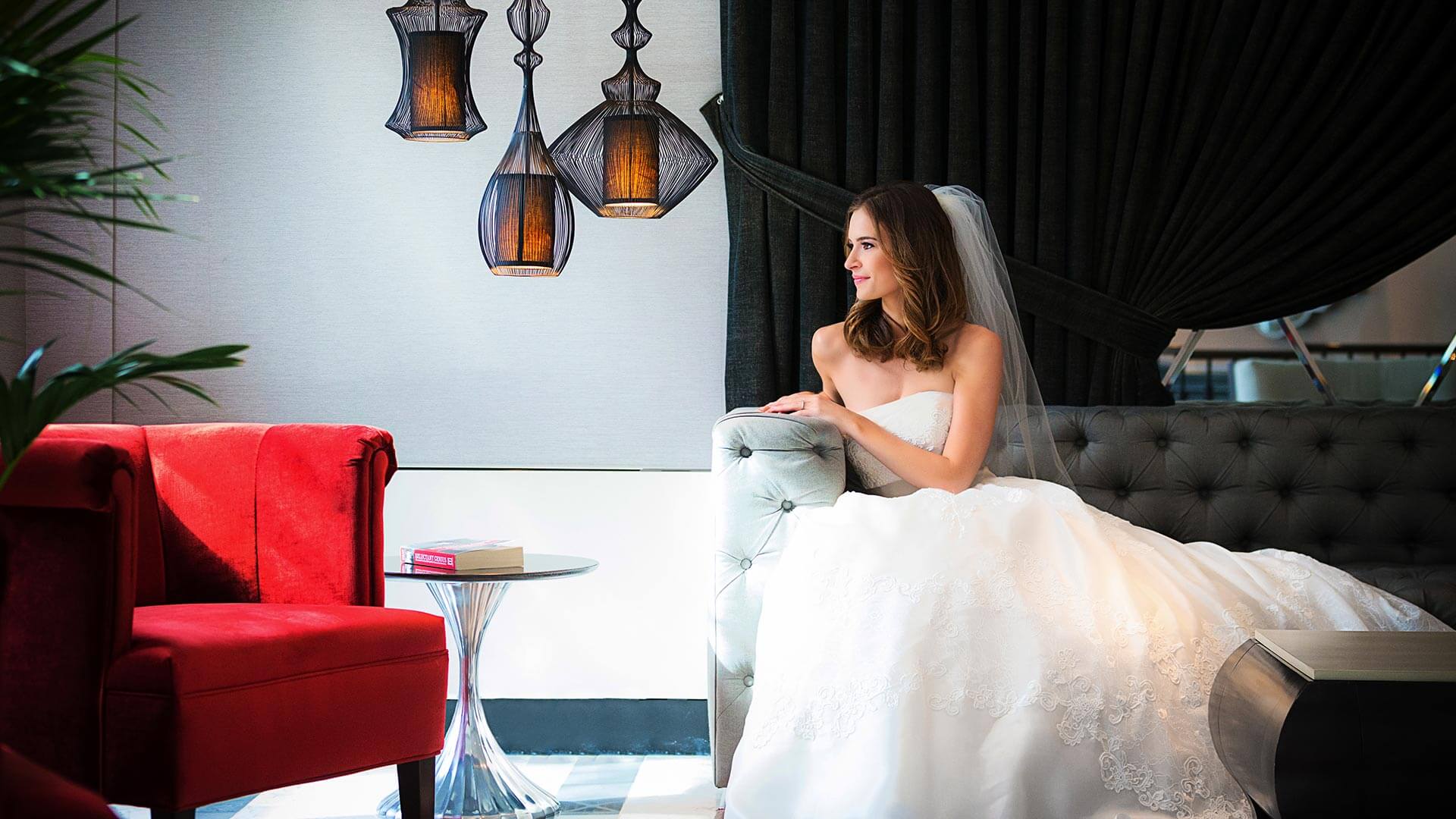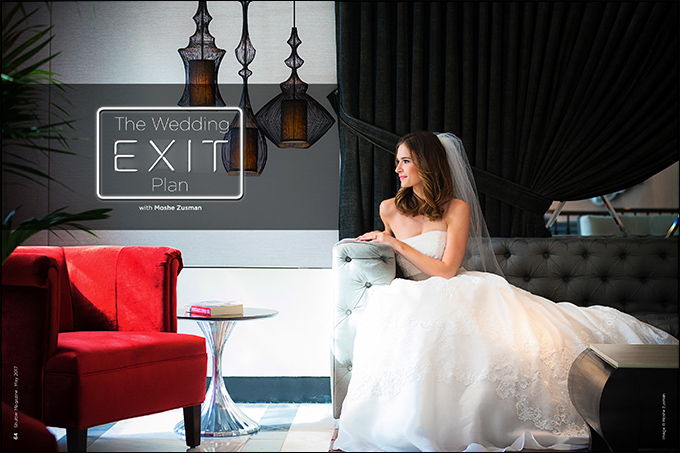The Wedding Exit Plan with Moshe Zusman
Want more information on this article? Get access to video content and additional supporting images. Launch the May issue of the magazine by logging in or signing up for a free account by clicking here. Shutter Magazine is the industry’s leading professional photography magazine.
Shooting weddings can get to the best of us. Maybe it’s when we are waiting for all the family members to come together for a big family photo in the middle of a wedding reception. Perhaps it is one of those moments when your bride turns against you. Or maybe the lifestyle of a wedding photographer has just become too much. Whatever it is, all wedding photographers face deep frustrations.
For me, this realization came around the time my first kid was born. I was shooting 40-plus high-end weddings a year and second-shooting as well. In addition to weddings, I photographed high-profile events and portraits.
Two months before Noah was born, I was living on top of the world, running a successful photography business in Washington, D.C. I was about to become a dad and was working harder than ever to get ready for it. I had doubled my prices and my bookings every year for the past few years to get my wedding photography business to where I wanted it. The first few years of being a family of three were life-altering, but not in the way most people describe. Sure, your Lexus is now a babymobile, and there are those sleepless nights too.
But the biggest change is the rest of your life. Weddings suddenly occupied a bigger part of my life than just another Saturday night. I was in denial that I’d become disenchanted with shooting them.
I was ready for a change.
I was getting that undeniable urge for an all-in moment to make a better life for my family and me. That’s when I decided it was my photography that needed to change. I had built this wedding photography business from scratch after moving to the U.S. from Israel, but now I had my wife and son hiding in a closet while I was trying to meet with clients. Noah was only just learning to walk, and I knew I never wanted to miss his baseball games.
Aside from the burnout of shooting weddings, this just wasn’t the lifestyle I wanted anymore. I wanted to be able to call out sick and not get sued for it. I wanted to be there when my kid was sick, and for it to be just a matter of rescheduling some clients for another day and not missing the most important day of someone’s life.
The idea of breaking into a new genre was terrifying. I wasn’t just afraid of failing, but afraid of failing my family. I knew that shooting in the studio would allow me to create my own weekday schedule and take control of my time. That’s when I started moving into fashion, portraits and headshots.
If I were to talk to someone doing what I did, I would tell them to treat this new business like pulling off a Band-Aid. First, get your portfolio together. Learn what you need to about studio photography. Unlike wedding photography, you don’t need to spend time second-shooting and doing styled shoots because you can practice headshots a lot more easily than you can practice weddings. You need only about 12 images, maybe 20, to create a full headshot portfolio.
It takes endless practice, but the learning curve is way shorter with headshots and portraits—primarily because of the difference in what I call “liability.” For weddings, you pay a great price for small mistakes. With studio work, it’s different. I called my friends, family and even past brides to come in and let me experiment with their headshots, all in one day, creating a portfolio I used on my website.
From there, I created a pricing, scheduling and a workflow structure that was seamless and hands-off. I changed the look of my studio to look more fashion-based, and started building my business from there.
I used Squarespace to design my website because it was fast and easy, and I was already using it for my wedding photography. I got a separate URL, HeadshotDC.com, for headshots and business portraits. I’ve created such a streamlined system that it takes me only an hour from the time the client looks at my website and decides to book me until I photograph them and deliver their final headshot. I make about $500 an hour this way, which is way better than photographing weddings. Weddings require a total of 40 to 50 hours from start to finish. I limit my bookings to a month or two out, eliminating that daunting feeling of being committed to jobs for the next two years.
Moving to studio photography was one of the best things I’ve done for my business and my personal life. If you have the chance to get to hear me speak at places like B&H Event Space, PhotoPlus Expo or Headshot Bootcamp, you’ll hear more about my story and how I get clients to book, pay and show up without having to send out a single email. When they come in for a basic headshot, I spend 10 to 15 minutes with them as they select their final images on the spot. I send the selected images to my in-house retoucher, who delivers the images in 24 to 48 hours. That’s it. No more culling through hundreds of images or waiting up to eight weeks to deliver proofs. And there’s no more chasing down clients for album choices years after their wedding.
In the studio, I shoot with a Canon 5Ds and the Canon EF 70–200mm f/2.8L IS II USM lens. I use Profoto D2 and Profoto light shapers, Savage Universal Backdrops and Tether Tools. There is a little crossover in switching from weddings to studio work. Your existing camera and lenses will be a good start, but it’s the lighting you’ll want to invest in the most.
I don’t hate weddings. I still do a few every year, and have recently rediscovered the fun of second-shooting, which is how I got started. But wedding work is the most physically and mentally challenging genre of photography. They demand too much of my most precious asset: time. Now, I spend most of my time photographing headshots for politicians, businesspeople, yogis, pageant contestants and health professionals in the D.C. area. I get to spend more time being creative on each individual picture, and that inspires and pushes me to be a more fine-tuned photographer.
If you’re ready to spend more time living than working, I recommend taking a look at headshot photography. Start out like I mentioned. Rip off the old like a Band-Aid, build a website and start marketing—which you can do in as little as 48 hours, like I teach at Headshot Bootcamp.
Grow your new business while stepping back from your other. Maybe you’ll love it, maybe you won’t. Maybe you’ll decide you still want to shoot weddings and do headshots on the side, or maybe you’ll change your life altogether.
The best thing about being a photographer is that we aren’t stuck doing something we no longer enjoy. We have the freedom to explore any genre we like and mold our lives how we please.
Want more information on this article? Get access to video content and additional supporting images. Launch the May issue of the magazine by logging in or signing up for a free account by clicking here. Shutter Magazine is the industry’s leading professional photography magazine.





